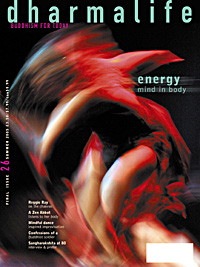After the deluge
The Indian Ocean tsunami caused deaths in 20 countries, and devastated Buddhist communities in Sri Lanka, Thailand, Myanmar and elsewhere. It also prompted generous responses from Buddhists in many other Asian countries.
Compassionate responses
In Sri Lanka 40,000 people died. Prominent among those responding was the Sarvodaya movement, which links 15,000 villages in self-help projects run on Buddhist principles. Just hours after the tidal wave struck Sarvodaya volunteers were finding accommodation and supplies for those affected. Especially active were the 100,000 members of the Shantisena youth movement. Sarvodaya is now focusing on reconstruction of 226 Sarvodaya villages, some of which need to be completely rebuilt. However, the worst affected were often those living on land between the coastal railway tracks and the sea. A government directive aimed at averting a recurrence of the disaster has banned new building and repairs within 100m of the sea, leaving these people destitute. www.sarvodaya.org
East Asian Buddhists also responded to the crisis, with donations being raised from the Shaolin monastery in China as well as many new Buddhist groups in Japan. Most active of all was Taiwan's Tzu Chi Foundation, founded by Master Chen Yen. This charity has relief teams that were able to respond immediately, and a fundraising network of half a million volunteers that rapidly enabled them to send hundreds of tons of relief supplies to affected regions. Among their longer-term projects is housing for 1,000 displaced families in Sri Lanka. www.tzuchi.org
In Malaysia 11,000 Buddhists came together for a Dharma Assembly to bless the Tsunami's victims, the biggest Buddhist gathering in recent times. The leading Buddhist temple in Kuala Lumpur was overwhelmed by donations of clothing, blankets and food in what one observer described as 'an anarchy of altruism'. Relief agencies insisted that the most useful form of donation was money.
The FWBO's charity, The Karuna Trust, focuses on Dalit communities (considered 'Untouchables' by caste Hindus) and long-term development work rather than emergency relief. The tsunami affected India's southeast coast, especially Tamil Nadu, where nearly 8,000 died, and attracted aid from the Indian government and NGOs. However, caste prejudice has meant that during the relief operations Dalits have been forced out of relief camps by higher-caste people, barred from drinking water from tanks, and expected to dispose of dead bodies because higher-caste people feared pollution if they handled them. Government compensation due to Dalits is still not reaching them.
By using the organisation's existing expertise and addressing the community's long-term needs, the Karuna Trust will be opening two educational hostels in the devastated region: one for 50 girls and another for 50 boys. They are also supporting relief efforts in Unawatune, southern Sri Lanka, led by a local member of the wbo, Dharmachari Saddhavira. www.karuna.org
Tales from the wreckage
The task of cremating thousands of tsunami victims fell largely to the monks in Thailand. Nearly 5,000 corpses, about half of them foreigners, piled up so quickly on the island of Phuket that there was not enough morgue space to store them. Ven Siripanyo Bhikkhu observed volunteers being overwhelmed. 'People are becoming traumatised within one or two days, operating on adrenaline, getting hardly any sleep.' He ascribed monks' greater capacity for this to the widespread practice of meditation on the image of a decomposing corpse, and experience of conducting cremations. 'It's very normal,' he said, 'very much at the heart of impermanence'.
Thai Buddhist monks also led mass cleansing rituals on the beaches to allay the ghostly spirits of the dead. Taxi drivers reported spirits of the dead flagging them down on the street, while others claimed they saw people swimming in the sea and singing on the beach at night. 'Food offerings, prayers and blessings were intended to generate merit that would enable the spirits of the dead to rest in peace.'
In Galle, Southern Sri Lanka, a Buddha image that survived unscathed while bystanders were swept away, prompted controversy. Indeed one bhikkhu claimed that this was a lesson. 'Nature has given [the victims] punishment because they are not following the path of the Lord Buddha. These people have to learn their lesson.'
Meanwhile, a five-inch Buddha image was washed ashore on a wooden raft decorated with flowers of silver foil in Meyyurkuppam on the southeast coast of India. When the villagers were told that it was an image of the Buddha, one said, 'We have heard of this god, but we don't know much about him.' It later emerged that the image had been washed out to sea from the waters of Myanmar and had floated for eight days across 1,000 miles of ocean before ending up in the village. 'He will be kept here,' said one of the fishermen. 'We are very happy with the arrival of this god.'



